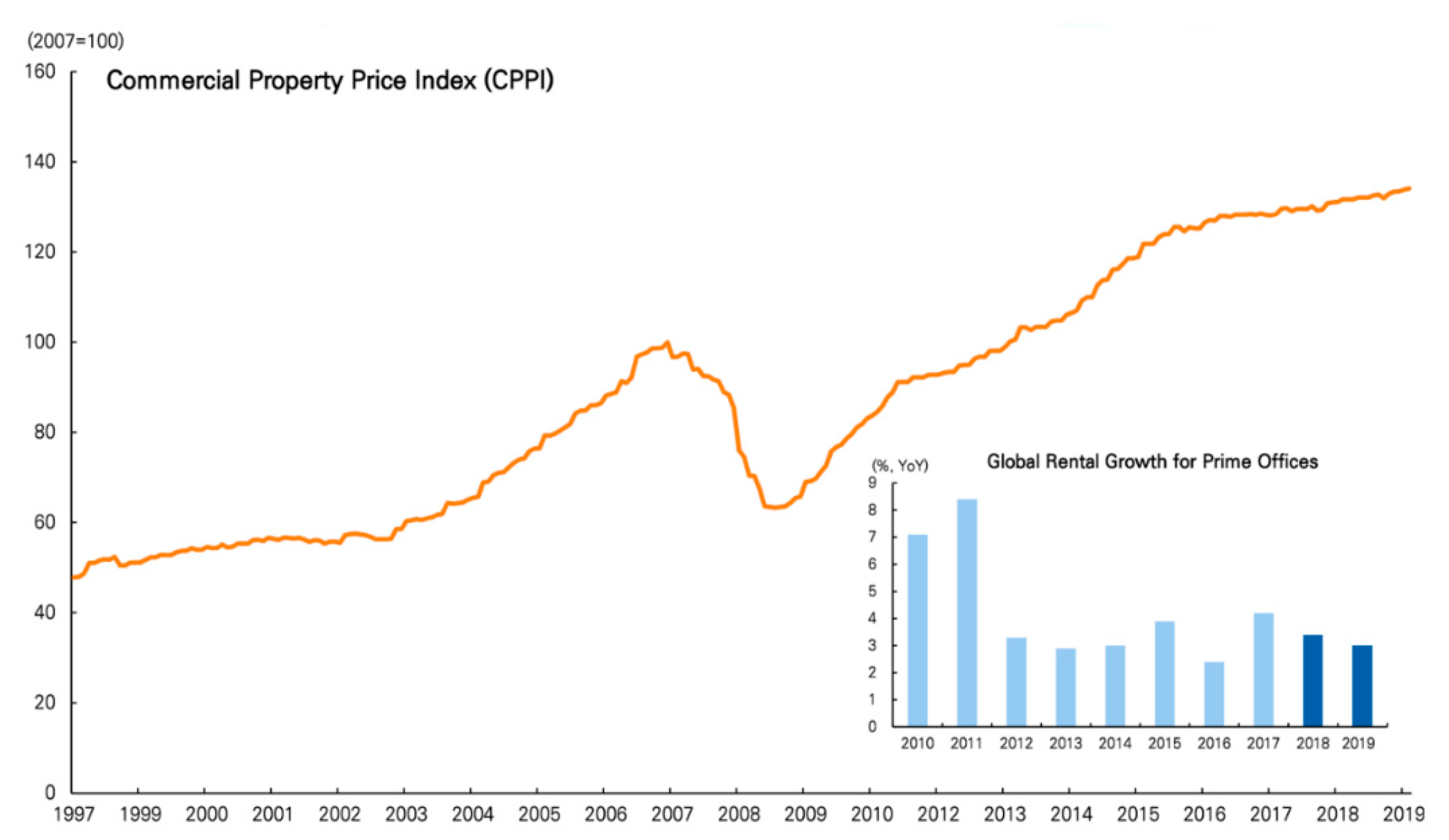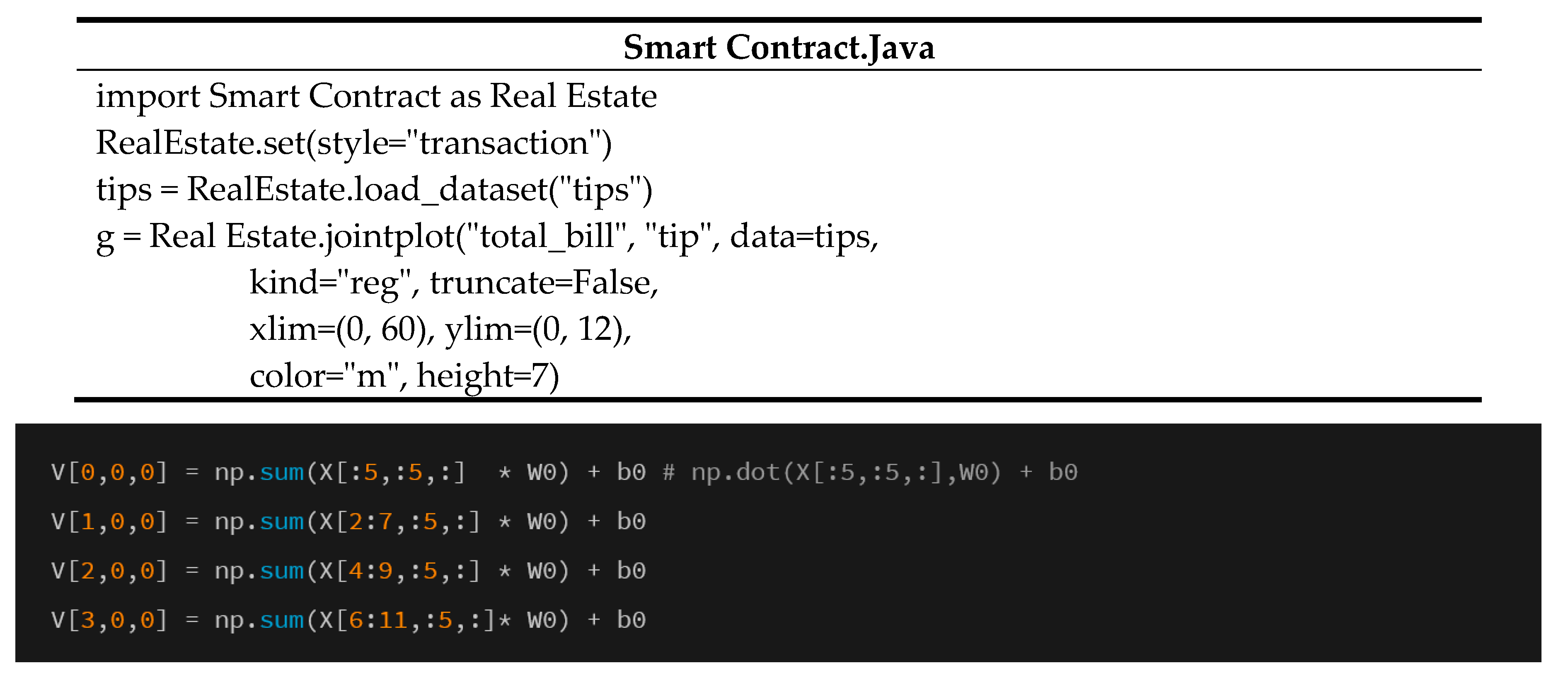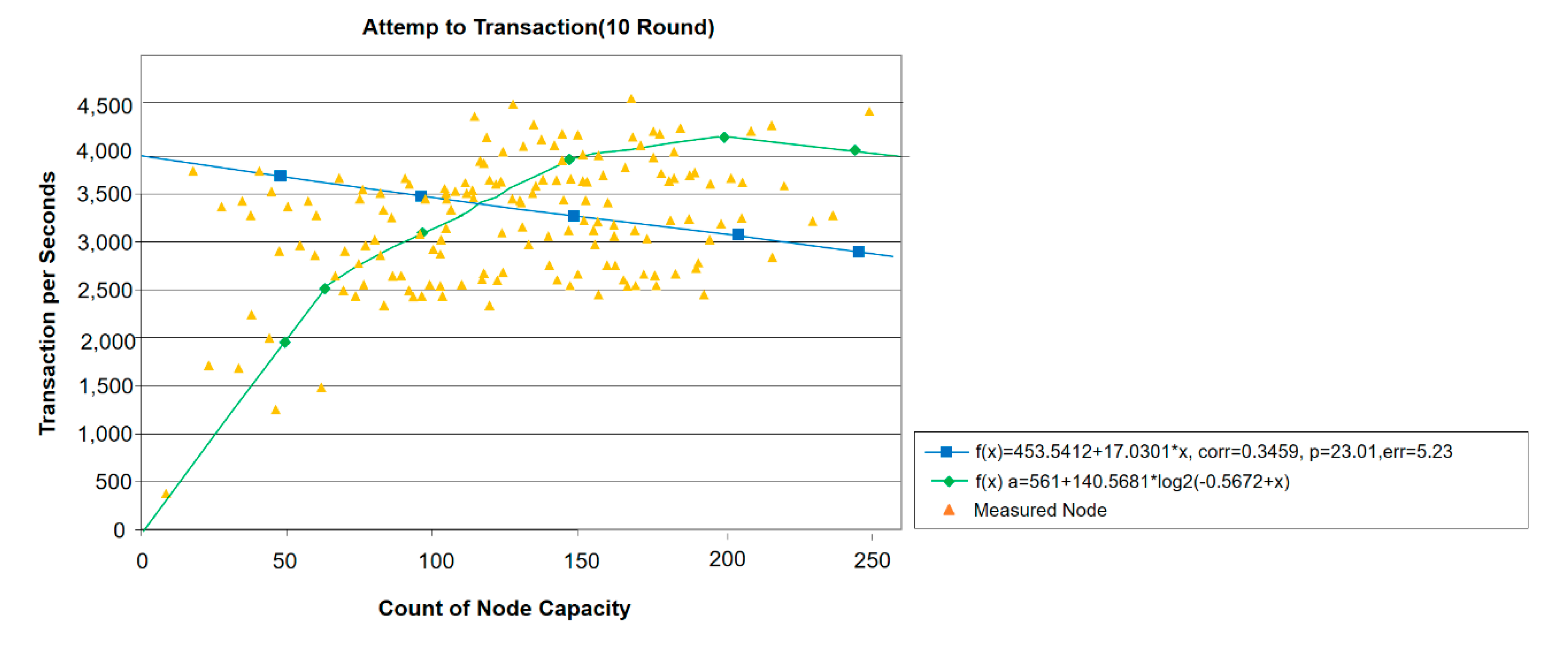Verification Plan Using Neural Algorithm Blockchain Smart Contract for Secure P2P Real Estate Transactions
Abstract
:1. Introduction
2. Related Research
2.1. Real Estate Market
2.2. Blockchain Smart Contracts for Real Estate
2.2.1. Save Records
2.2.2. Product Inquiry
2.2.3. Contract Fulfillment
2.3. Deep Belief Network
2.4. Security and Privacy
3. Neural Algorithm Blockchain Smart Contract for Secure P2P Real Estate Transactions
3.1. VM Study Methodology for Blockchain Real Estate Contract Validation
3.1.1. Study Methodology
- Credentials
- Key pair for credentials
- Verifier information
- Credentials result
- Verifier information result
3.1.2. Lightweight Secure Password Virtual Machine
3.1.3. Test Verification Tool for Lightweight Security IoT Gateway (GW)
3.2. Blockchain Smart Contract VM Model
3.2.1. Test Verification Tool for Network-Based Lightweight Security IoT GW (Terminal Mounted SW)
3.2.2. Reserved Server (Server-Mounted S/W)
3.2.3. Monitoring Server (Server-Mounted S/W)
3.3. Blockchain Smart Contract Key Features
3.3.1. Lightweight Secure Password Language Interpreter
- Ability to perform elastic curve primitives analysis.
- New encryption model template functionality.
- ElGamal commission features.
- Bone–Lynn–Schacham (BLS) coupling for short signature.
- Elastic curve Qu-Vanstone (ECQV) certificate-based technology.
- Ability to upload script formats inside the VM.
- Encryption library APIs and crypto implementation non-subjectivity features.
- Property-based qualification technology.
3.3.2. Lightweight Secure Password Virtual Machine
- Lightweight memory manager (4-byte default).
- Single call form function.
- Copy results within memory buffer.
- JSON format information call function.
- Bindings of various languages (minimum of three types or more).
- Provides deployment of x86 or ARM architecture.
- JavaScript/Webassembly compilation features.
- Android/iOS library offerings.
3.3.3. Test Verification for Lightweight Secure IoT GW
- Web service features to create Contracts.
- Web-style file upload feature.
- Asymmetric AES-GCM test function.
3.3.4. One Lightweight Secure IoT GW SYSTEM
- Ability to upload and mount lightweight secure virtual machines.
- Test command tool for testing lightweight secure virtual machines.
- Secure operation check function in conjunction with various sensors.
3.4. Quantum Cryptography Method
3.4.1. Quantum Proof-Based Algorithm
- Each new program requires a new setup, which in turn creates a new key.
- Memory access or repeat count of repeat statements cannot vary depending on the program’s input value.
- Allowing data dependence on memory access requires heavy work, such as verification of the muffler pass.
- Supports any program, but the circuit size increases inefficiently relative to the program size.
- ∂X(l)k,m,n∂W(l)k,i,j = ∂∂W (l)k,i,j{W(l)k,i,jf(X(l − 1)k,(i + m),(j + n))}
- ∂X(l)k,m,n∂W(l)k,i,j = f(X(l − 1)k,(i + m),(j + n))
3.4.2. Quantum Proof-Based Algorithm
3.4.3. Virtual Machine Calculator
3.4.4. Quantum Proof-Based Architecture
3.5. Deep Learning Smart Contract
4. Program Class-Diagram and Source Code
4.1. Program Class-Diagram
- Measure the memory usage of lightweight rock-dissolving virtual machines
- Establish an environment for monitoring memory usage and measure memory usage
- Binary size for lightweight rockfish virtual machines
- Build a build environment, create a binary, and measure its size
- Speed of blockification of lightweight rockfish virtual machines
- Establish a debugging environment and measure the speed of cryptography in virtual machines
- Property-based identity assurance speed
- After establishing an environment for issuer, holder, and verifier, the holder is created
- Request to the issuer and measure the speed of identity assurance up to the stage where the verifier verifies it
4.2. Program Source Code
5. Experimental Method
5.1. Performance Measurement Evaluation Items
- Measure memory usage of lightweight rock-dissolving virtual machines
- Establish an environment for monitoring memory usage and measure memory usage
- Binary size for lightweight rockfish virtual machines
- Build a build environment, create a binary, and measure its size
- Speed of blockification of lightweight rockfish virtual machines
- Establish a debugging environment and measure the speed of cryptography in virtual machines
- Property-based identity assurance speed
- After establishing an environment for issuer, holder, and verifier, the holder is created
- Request to the issuer and measure the speed of identity assurance up to the stage where the verifier verifies it.
5.2. Performance Measurement Offering
5.3. Performance Measurement Data
6. Discussion
6.1. Discussion
6.2. Smart Contract-Based Real Estate Blockchain
7. Conclusions
Supplementary Materials
Author Contributions
Funding
Conflicts of Interest
Abbreviations
| P2P APIs BLS ECP ECQV | Peer-to-Peer Application Programming Interface Bone–Lynn–Schacham Elliptic Curve Primitives Elastic Curve Qu-Vanstone |
| GW | Gateway |
| IoT | Internet of Things |
| GPS ARM LLVM | Global Positioning System Advanced RISC Machine Low Level Virtual Machine |
| PBFT | Practical Byzantine Fault Tolerance |
| RBM | Restricted Boltzmann Machine |
| REITs | Real Estate Investment Trusts |
| SDK | Software Development Kit |
| TPS | Transaction Per Second |
| UML | Unified Modeling Language |
| VM | Virtual Machine |
References
- Hák, T.; Janoušková, S.; Moldan, B. Sustainable Development Goals: A need for relevant indicators. Ecol. Indic. 2016, 60, 565–573. [Google Scholar] [CrossRef]
- Bizon, N. Efficiency and Sustainability of the Distributed Renewable Hybrid Power Systems Based on the Energy Internet, Blockchain Technology and Smart Contracts. Sustainability. Available online: https://www.mdpi.com/journal/sustainability/special_issues/Distributed_Renewable_Hybrid_Power_Systems (accessed on 6 May 2020).
- Seong-Kyu, K.; Ung-Mo, K.; Jun-Ho, H. A study on improvement of blockchain application to overcome vulnerability of IoT multiplatform security. Energies 2019, 12, 402. [Google Scholar]
- James, B.; Michael, C. How utilities are using blockchain to modernize the grid. Harv. Bus. Rev. 2017, 23, 1–8. [Google Scholar]
- Griggs, D.; Stafford-Smith, M.; Gaffney, O.; Rockström, J.; Öhman, M.C.; Shyamsundar, P.; Noble, I. Policy: Sustainable development goals for people and planet. Nature 2013, 495, 305. [Google Scholar] [CrossRef]
- Corea, F. AI and Blockchain. In An Introduction to Data; Studies in Big Data; Springer: Cham, Swizerland, 2019; Volume 50, pp. 69–76. [Google Scholar]
- Chowdhury, M.J.; Ferdous, M.S.; Biswas, K.; Chowdhury, N.; Kayes, A.; Alazab, M.; Watters, P. A comparative analysis of distributed ledger technology platforms. IEEE Access 2019, 7, 167930–167943. [Google Scholar] [CrossRef]
- Kuo, T.T.; Zavaleta, R.H.; Ohno-Machado, L. Comparison of blockchain platforms: A systematic review and healthcare examples. J. Am. Med. Inform. Assoc. 2019, 26, 462–478. [Google Scholar] [CrossRef]
- Macdonald, M.; Liu-Thorrold, L.; Julien, R. The Blockchain: A Comparison of Platforms and Their Uses beyond Bitcoin; COMS4507-Advanced Computer and Network Security: 2017. Available online: https://www.researchgate.net/profile/Lisa_Liu-Thorrold/publication/313249614_The_Blockchain_A_Comparison_of_Platforms_and_Their_Uses_Beyond_Bitcoin/links/5894447baca27231daf63689/The-Blockchain-A-Comparison-of-Platforms-and-Their-Uses-Beyond-Bitcoin.pdf (accessed on 6 May 2020).
- Beverly, Y.; Garcia-Molina, H. Pay: Micropayments for peer-to-peer systems. In Proceedings of the 10th ACM Conference on Computer and Communications Security, Washington, DC, USA, 27–31 October 2003; ACM: New York, NY, USA, 2003; pp. 300–310. [Google Scholar]
- Lee, S.; Woo, H.; Shin, Y. Study on Personal Information Leak Detection Based on Machine Learning. Adv. Sci. Lett. 2017, 23, 12818–12821. [Google Scholar] [CrossRef]
- Mnih, V.; Kavukcuoglu, K.; Silver, D.; Rusu, A.A.; Veness, J.; Bellemare, M.G.; Petersen, S. Human-level control through deep reinforcement learning. Nature 2015, 518, 529–533. [Google Scholar] [CrossRef]
- Silver, D.; Schrittwieser, J.; Simonyan, K.; Antonoglou, I.; Huang, A.; Guez, A.; Chen, Y. Mastering the game of go without human knowledge. Nature 2017, 550, 354–359. [Google Scholar] [CrossRef]
- DeepMind. AlphaGo Zero: Learning from the Scratch. Available online: https://deepmind.com/blog/alphago-zero-learning-scratch/ (accessed on 27 March 2020).
- Bengio, Y.; Courville, A.; Vincent, P. Representation learning: A review and new perspectives. IEEE Trans. Pattern Anal. Mach. Intell. 2013, 35, 1798–1828. [Google Scholar] [CrossRef] [PubMed]
- Wachsmuth, I.; Lenzen, M.; Knoblich, G. Embodied Communication in Humans and Machines; Oxford University Press: Oxford, UK, 2008. [Google Scholar]
- Picard, R.W. Computer learning of subjectivity. ACM Comput. Surv. 1995, 27, 621–623. [Google Scholar] [CrossRef]
- Charles, D. The Expression of Emotions in Animals and Man; Murray: London, UK, 1872; pp. 11–45. [Google Scholar]
- Judith, E.; James, M.D.; Latane, B. Gregariousness in rats as a function of familiarity of environment. J. Personal. Soc. Psychol. 1969, 11, 107. [Google Scholar]
- Sodhro, A.H.; Pirbhulal, S.; Hugo, V.; de Albuquerque, C. Artificial intelligence-driven mechanism for edge computing-based industrial applications. IEEE Trans. Ind. Inform. 2019, 15, 4235–4243. [Google Scholar] [CrossRef]
- Wang, Z.; Peterson, J.L.; Rea, C.; Humphreys, D. Special issue on machine learning, data science, and artificial intelligence in plasma research. IEEE Trans. Plasma Sci. 2020, 48, 1–2. [Google Scholar] [CrossRef]
- Wang, Y.; Kwong, S.; Leung, H.; Lu, J.; Smith, M.H.; Trajkovic, L. Brain-inspired systems: A transdisciplinary exploration on cognitive cybernetics, humanity, and systems science toward autonomous artificial intelligence. IEEE Syst. Man Cybern. Mag. 2020, 6, 6–13. [Google Scholar] [CrossRef]
- Watkins, T. Cosmology of artificial intelligence project: Libraries, makerspaces, community and AI literacy. ACM AI Matters 2020, 4, 134–140. [Google Scholar] [CrossRef]
- Seo, Y.-S.; Huh, J.-H. Automatic emotion-based music classification for supporting intelligent IoT applications. Electronics 2019, 8, 164. [Google Scholar] [CrossRef] [Green Version]
- Manoj, N.; Kumara, P.; Mallickb, K. Blockchain technology for security issues and challenges in IoT. Procedia Comput. Sci. 2018, 132, 1815–1823. [Google Scholar]
- Alfandi, O.; Otoum, S.; Jararweh, Y. Blockchain solution for IoT-based critical infrastructures: Byzantine fault tolerance. In Proceedings of the NOMS 2020–2020 IEEE/IFIP Network Operations and Management Symposium, Budapest, Hungary, 20–24 April 2020. [Google Scholar]
- Aloqaily, M.; Boukerche, A.; Bouachir, O.; Khalid, F.; Jangsher, S. An energy trade framework using smart contracts: Overview and challenges. IEEE Netw. 2020, 1–7. [Google Scholar] [CrossRef]
- Tseng, L.; Wong, L.; Otoum, S.; Aloqaily, M.; Othman, J.B. Blockchain for managing heterogeneous internet of things: A perspective architecture. IEEE Netw. 2020, 34, 16–23. [Google Scholar] [CrossRef]
- Akkaoui, R.; Hei, X.; Cheng, W. EdgeMediChain: A hybrid edge. Blockchain-based framework for health data exchang. IEEE Access 2020. [Google Scholar] [CrossRef]
- Liu, J.; Guo, S.; Shi, Y.; Feng, L.; Wang, C. Decentralized caching framework towards edge network based on blockchain. IEEE Access 2020. [Google Scholar] [CrossRef]
- Watson, D.; Tellegen, A. Toward a consensual structure of mood. Psychol. Bull. 1985, 98, 219–235. [Google Scholar] [CrossRef] [PubMed]
- Huh, J.-H.; Kim, S.-K. The blockchain consensus algorithm for viable management of new and renewable energies. Sustainability 2019, 11, 3184. [Google Scholar] [CrossRef] [Green Version]
- Burford, G.; Hoover, E.; Velasco, I.; Janoušková, S.; Jimenez, A.; Piggot, G.; Harder, M.K. Bringing the “missing pillar” into sustainable development goals: Towards intersubjective values-based indicators. Sustainability 2013, 5, 3035–3059. [Google Scholar] [CrossRef] [Green Version]
- Gisbert, G. Policy: Base sustainable development goals on science. Nature 2012, 491, 35. [Google Scholar]
- Wang, H.; He, D.; Ji, Y. Designated-verifier proof of assets for bitcoin exchange using elliptic curve cryptography. Future Gener. Comput. Syst. 2017, 107, 21–24. [Google Scholar] [CrossRef]
- Löbbe, S.; Hackbarth, A. Chapter 15: The Transformation of the German Electricity Sector and the Emergence of New Business Models in Distributed Energy Systems; Elsevier: Amsterdam, The Netherlands, 2017; pp. 287–318. [Google Scholar]
- Keesstra, S.D.; Bouma, J.; Wallinga, J.; Tittonell, P.; Smith, P.; Cerdà, A.; Bardgett, R.D. The significance of soils and soil science towards realization of the United Nations Sustainable Development Goals. Soil 2016, 2, 111–128. [Google Scholar] [CrossRef] [Green Version]
- Chen, Y. Blockchain tokens and the potential democratization of entrepreneurship and innovation. Bus. Horiz. 2017, 61, 567–575. [Google Scholar] [CrossRef]
- Kshetri, N. Blockchain’s roles in meeting key supply chain management objectives. Int. J. Inform. Manag. 2018, 39, 80–82. [Google Scholar] [CrossRef] [Green Version]
- Savelyev, A. Copyright in the blockchain era: Promises and challenges. Comput. Law Secur. Rev. 2018, 34, 550–561. [Google Scholar] [CrossRef] [Green Version]
- Hajer, M.; Nilsson, M.; Raworth, K.; Bakker, P.; Berkhout, F.; De Boer, Y.; Kok, M. Beyond cockpit-ism: Four insights to enhance the transformative potential of the sustainable development goals. Sustainability 2015, 7, 1651–1660. [Google Scholar] [CrossRef] [Green Version]
- Dorri, A.; Kanhere, S.S.; Jurdak, R.; Gauravaram, P. Blockchain for IoT security and privacy: The case study of a smart home. In Proceedings of the 2017 IEEE International Conference on Pervasive Computing and Communications Workshops (PerComWorkshops), Kona, HI, USA, 13–17 March 2017. [Google Scholar]
- Imbault, F.; Swiatek, M.; De Beaufort, R.; Plana, R. The green blockchain: Managing decentralized energy production and consumption. In Proceedings of the 2017 IEEE International Conference on Environment and Electrical Engineering and 2017 IEEE Industrial and Commercial Power Systems Europe (EEEIC/I&CPS Europe), Milan, Italy, 6–9 June 2017; IEEE: Piscataway, NJ, USA, 2017; pp. 1–5. [Google Scholar]
- Underwood, S. Blockchain beyond Bitcoin. Communications of the ACM; ACM: New York, NY, USA, 2016; Volume 59, pp. 15–17. [Google Scholar]
- Wang, W.; Chang, Y.; Wang, H. An Application of the spatial autocorrelation method on the change of real estate prices in Taitung City. ISPRS Int. J. Geo-Inf. 2019, 8, 249. [Google Scholar] [CrossRef] [Green Version]
- Jayantha, W.M.; Yung, E.H.K. Effect of Revitalisation of historic buildings on retail shop values in urban renewal: An empirical analysis. Sustainability 2018, 10, 1418. [Google Scholar] [CrossRef] [Green Version]
- Bełej, M.; Figurska, M. 3D Modeling of Discontinuity in the spatial distribution of apartment prices using voronoi diagrams. Remote Sens. 2019, 12, 229. [Google Scholar] [CrossRef] [Green Version]


















| Public Blockchain | Private Blockchain | Consortium Blockchain | |
|---|---|---|---|
| Management Subject | All Participants | Managed by central institution | Participants in the Consortium |
| Network Participating Condition | Non | Managed by central institution | Non or managed by selected institution |
| Transaction Speed | Slow | Quick | Quick |
| Identification | Anonymous | Identifiable | Identifiable |
| Transaction Proof | Proof of work Algorithm, Transaction verifier cannot be known in advance | Transaction verification is made by central institution. | Transaction verifier is known through certification. Transaction verification and block |
| Quantitative Objective Items | Preparing for Evaluation | Evaluation Method | Composition of Test Network |
|---|---|---|---|
| Preprocessing time | Network configuration using nodes with four preprocessing. | Perform pretreatment for a total of 10 times and derive the average. | Blockchain—four nodes. One load test node. |
| Percentage of real-time throughput of preprocessing code | Network configuration using nodes with four preprocessing capabilities. Network configuration using nodes that exclude four preprocessing functions. | Load zoom (60 min) using uniform remittance transactions across all nodes. Average speed is obtained according to the procedure above. Measure a total of 10 repetitions and derive the average. | Blockchain—eight nodes. Two load test nodes |
| Real-time transaction performance | Configure your network using four nodes. | Load zoom (60 min) using uniform remittance transactions across all nodes. Average speed is obtained according to the procedure above. Measure a total of 10 repetitions and derive the average. | Blockchain—16 nodes. One load test node |
© 2020 by the authors. Licensee MDPI, Basel, Switzerland. This article is an open access article distributed under the terms and conditions of the Creative Commons Attribution (CC BY) license (http://creativecommons.org/licenses/by/4.0/).
Share and Cite
Huh, J.-H.; Kim, S.-K. Verification Plan Using Neural Algorithm Blockchain Smart Contract for Secure P2P Real Estate Transactions. Electronics 2020, 9, 1052. https://doi.org/10.3390/electronics9061052
Huh J-H, Kim S-K. Verification Plan Using Neural Algorithm Blockchain Smart Contract for Secure P2P Real Estate Transactions. Electronics. 2020; 9(6):1052. https://doi.org/10.3390/electronics9061052
Chicago/Turabian StyleHuh, Jun-Ho, and Seong-Kyu Kim. 2020. "Verification Plan Using Neural Algorithm Blockchain Smart Contract for Secure P2P Real Estate Transactions" Electronics 9, no. 6: 1052. https://doi.org/10.3390/electronics9061052
APA StyleHuh, J. -H., & Kim, S. -K. (2020). Verification Plan Using Neural Algorithm Blockchain Smart Contract for Secure P2P Real Estate Transactions. Electronics, 9(6), 1052. https://doi.org/10.3390/electronics9061052






